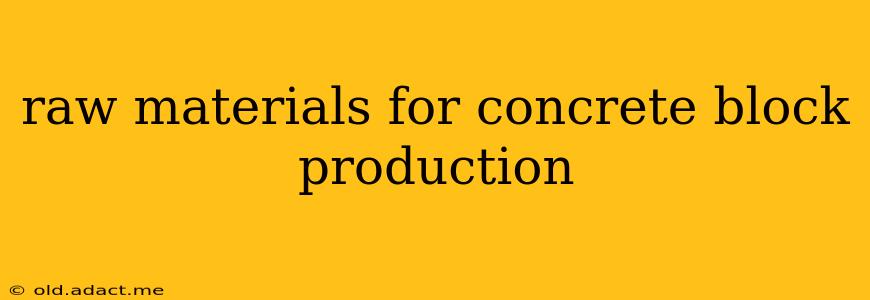Concrete blocks, ubiquitous in construction worldwide, are surprisingly simple in their composition. However, understanding the precise raw materials and their impact on the final product's quality is crucial for both manufacturers and consumers. This guide delves into the essential components, exploring their properties and how they contribute to the strength, durability, and overall performance of concrete blocks.
What are the Main Raw Materials for Concrete Blocks?
The primary ingredients for making concrete blocks are cement, aggregates (fine and coarse), and water. However, the precise mix and quality of these materials significantly influence the block's final characteristics. Let's explore each component in detail:
1. Cement: The Binding Agent
Cement acts as the glue, binding the aggregates together to create a solid, monolithic mass. The type of cement used directly impacts the block's properties, such as its strength, setting time, and resistance to various environmental factors. Portland cement is the most common type, known for its high compressive strength and relatively fast setting time. However, other types, such as blended cements (containing supplementary cementitious materials like fly ash or slag), are increasingly employed to enhance sustainability and specific performance characteristics.
2. Aggregates: The Fillers
Aggregates make up the bulk of the concrete block's volume. They are broadly classified into fine aggregates and coarse aggregates.
-
Fine Aggregates: These are typically sand particles, providing a filling material between the larger coarse aggregates and improving the workability of the concrete mix. The grading (size distribution) of the sand is crucial; well-graded sand leads to a denser and stronger block.
-
Coarse Aggregates: These are larger particles, usually crushed stone, gravel, or recycled concrete. The size and shape of these aggregates impact the block's strength and density. Crushed stone generally provides higher strength compared to gravel due to its angular shape, which interlocks better.
3. Water: The Essential Component
Water is crucial for the hydration process, the chemical reaction between cement and water that binds the aggregates together. The amount of water used affects the workability and strength of the concrete. Too much water weakens the block, while too little makes it difficult to work with. The quality of the water is also important; impurities can negatively impact the cement's hydration and the block's durability.
What Other Materials are Sometimes Added?
Beyond the core ingredients, several additives can be incorporated to improve specific properties of the concrete blocks:
-
Admixtures: These chemicals are added in small quantities to modify the concrete's properties. Examples include air-entraining agents (improving freeze-thaw resistance), water reducers (increasing workability), and accelerators (reducing setting time).
-
Pigments: Pigments are added to change the color of the blocks, offering aesthetic variety.
-
Fly Ash/Slag: These are by-products of industrial processes, increasingly used as supplementary cementitious materials to enhance sustainability and sometimes compressive strength.
How Do Different Raw Materials Affect the Concrete Block?
The choice of raw materials significantly influences several aspects of the final concrete block:
-
Strength: The type and quality of cement and aggregates, along with the water-cement ratio, directly impact the compressive strength of the block.
-
Durability: The use of air-entraining admixtures and appropriate aggregates improves the block's resistance to weathering, freezing, and thawing.
-
Workability: The grading of aggregates and the use of water reducers influence how easily the concrete can be molded and compacted.
-
Cost: The price of raw materials varies significantly depending on location and availability. Using alternative aggregates or supplementary cementitious materials can offer cost-effective solutions.
-
Sustainability: Utilizing recycled materials like recycled concrete aggregates and industrial by-products enhances the environmental sustainability of concrete block production.
What are the Different Types of Aggregates Used?
Types of Aggregates Used in Concrete Block Production:
This question addresses the variability within the "aggregates" category. Different aggregate types impart unique properties:
-
Crushed Stone: Offers superior strength due to its angular shape, creating better interlock between particles. Various stone types exist, each with different strength and durability characteristics.
-
Gravel: Generally less strong than crushed stone due to its rounded shape, but readily available and often more economical.
-
Recycled Concrete Aggregate (RCA): A sustainable option, using crushed recycled concrete as an aggregate. Its properties can vary based on the source material, requiring careful quality control.
-
Sand: The fine aggregate, essential for filling the voids between coarser materials and ensuring a dense, workable mix. Different sand types exist (e.g., river sand, manufactured sand), each affecting the mix's properties.
How does the water-cement ratio impact the strength of concrete blocks?
A lower water-cement ratio generally leads to higher strength because it results in a denser concrete mix with less porosity. More water weakens the concrete by creating more voids, decreasing its overall strength and durability. Optimizing the water-cement ratio is crucial for achieving the desired strength and durability in concrete blocks.
This comprehensive guide provides a detailed understanding of the raw materials used in concrete block production and their influence on the final product's quality and properties. By carefully selecting and managing these materials, manufacturers can ensure the production of high-quality, durable, and cost-effective concrete blocks.
